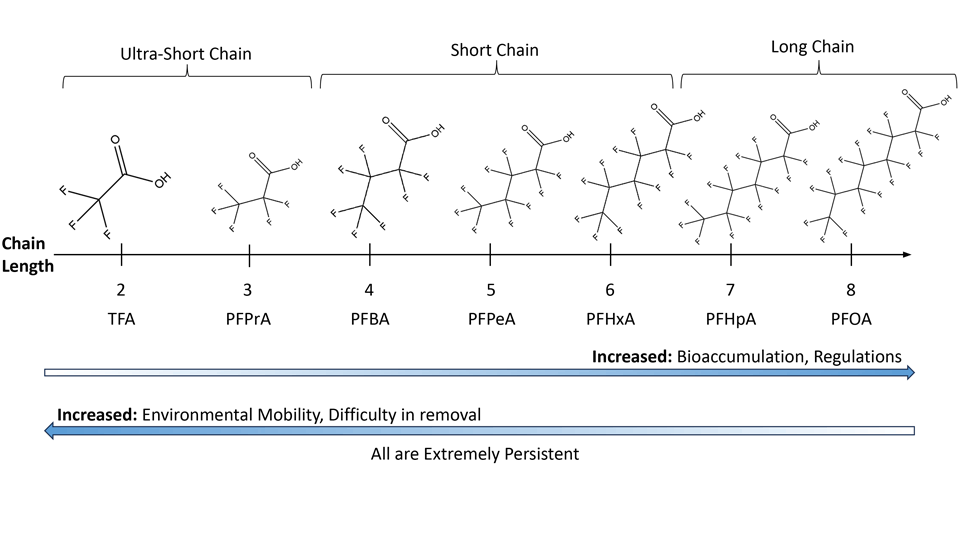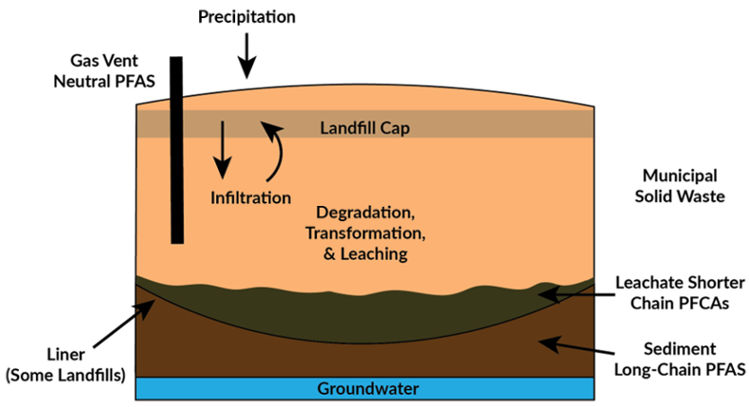Sorting Through the Science: Unearthing the Role of Short-Chain PFAS in Solid Waste Management
January 23, 2024
Author: Aquagga, Inc.
In recent years, awareness of per- and polyfluoroalkyl substances (PFAS) in the solid waste community has surged, prompting a wave of research into their sources and types. This increased scrutiny has unveiled a complex web of PFAS, particularly short-chain variants, in landfills. With this growing understanding comes an urgent need to address the environmental and health implications of these persistent chemicals in our waste management systems. This article delves into the intricate world of short-chain PFAS, their journey from common products to landfills, the challenges they pose in solid waste management, and the risks associated with continued human exposure to these chemicals.
Chains of Thought: Differentiating Long, Short, & Ultra-Short PFAS
PFAS compounds are often categorized based on their chain length: ultra-short, short, and long. While the differentiation isn’t exact, ultra-short-chain PFAS, the smallest, are typically considered to contain two to three carbon atoms, short-chain PFAS have four to six, and long-chain PFAS typically have seven or more. These chain lengths influence their environmental mobility, biological accumulation, and most importantly their relative difficulty to treat. Ultra-short and short-chain PFAS are more water-soluble and less bioaccumulative, but they are still persistent in the environment. Ultra-short and short-chain PFAS are also much more difficult to separate from contaminated water with typical treatment approaches like granular activated carbon (GAC) or ion exchange (IX) filtration. Long-chain PFAS, while less mobile, tend to bioaccumulate more significantly, leading to greater potential for long-term environmental and health impacts. The chain length thus critically determines the behavior and risks associated with each PFAS type.

Linking the Chains: Where Different PFAS Appear in Landfills
In landfills, different types of PFAS are found in distinct matrices, highlighting their diverse environmental behaviors. Long-chain PFAS, particularly PFOS and its precursors, are dominant in sediment, reflecting their tendency to accumulate in solid phases. Shorter-chain perfluorocarboxylic acids (PFCAs) are more prevalent in landfill leachate due to their higher solubility, a shift in industrial production favoring shorter chains, and potential transformations from other compounds. Additionally, neutral PFAS, such as fluorotelomer alcohols used in the production of various compounds, are detected in landfill air emissions, illustrating the complexity of PFAS distribution across different landfill components.

Chain Reaction: Understanding the Human Impact
Recent studies indicate an increase in short-chain PFAS, such as perfluorobutanoic acid (PFBA) and perfluorohexanesulfonic acid (PFHxS), in residential environments and the human body. Additional compounds that are not typically sampled for, including trifluoroacetic acid (TFA) and perfluoropropionic acid (PFPrA), are also prevalent in household dust and drinking water and are detectable in human blood and urine. While the health risks of long-chain PFAS are well-documented, including developmental issues and increased cancer risk, research is ongoing to explore the health impacts of short-chain PFAS, including studies on the toxicity of TFA to aquatic organisms. This correlation between domestic PFAS levels and their presence in the body highlights a need for regulation.
Chain of Custody: Short-Chain PFAS and the Growing Compliance Challenge
With increasing awareness of the breadth of PFAS compounds present in landfills and growing concerns around human exposure, we expect that regulations on short-chain and ultra-short-chain PFAS entering wastewater treatment plants will tighten significantly in the near future. European PFAS manufacturers are already halting production facilities due to heavy fines tied to ultra-short-chain PFAS discharge, and drinking water guidelines for ultra-short-chain PFAS are emerging in Europe. The United States is likely to follow suit in the coming years, buoyed by 3M’s commitment to stop PFAS production by 2025 and other prominent American companies voluntarily phasing out PFAS. New regulations will undoubtedly impact landfill operation, with improved treatment and management of PFAS-laden waste essential to environmental and discharge compliance. Due to their higher solubility, removing short and ultra-short chain PFAS will be even more challenging, and inherently more costly. Landfill managers would do well to consider ultra-short-chain and short-chain PFAS in their leachate management strategies, to avoid having to implement additional costly treatment equipment in the future.
Breaking the Chains: Benefits of PFAS Destruction
The dynamic regulatory environment underscores the urgent need for effective and innovative treatment methods. These approaches must be capable of safely removing and breaking down PFAS of all chain lengths, including long, short, and ultra-short chains, to mitigate their widespread impact on health and ecosystems. Aquagga’s hydrothermal alkaline treatment (HALT) technology has demonstrated complete destruction of all types of PFAS, including ultra-short-chain PFAS, in complex matrices such as landfill leachate and industrial wastewater. The development of emerging technologies, like HALT, offers a solution to tackling the impacts of PFAS across the United States and beyond. Reach out to our team of experts to discuss the implementation of cutting-edge technologies to address your site management needs.







Leave a comment